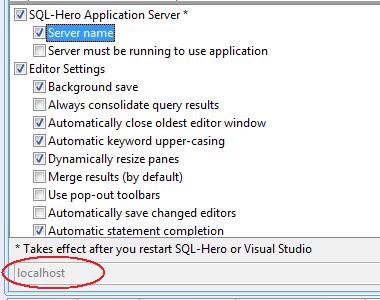Which SQL-Hero Edition is Right for You?
This page discusses various scenarios your business or development shop might encounter and how it relates to SQL-Hero licensing. We strive to make sure you don’t have to pay any more than you need to in order to achieve a successful SQL-Hero deployment – so although this is not exhaustive, it will hopefully be instructive.
Scenario #1 – Single developer
As a single developer, you might be most interested in SQL-Hero features such as the enhanced editor with Visual Studio integration, schema compares, data compares, and other tools. If this is the case, you would likely use a single Developer Edition license. If you are a DBA and only interested in basic features, the Lite Edition may be sufficient. Consult the Features matrix for more comparative details.
If you’re interested in features like user-defined properties, code generation, unit and performance testing, and change tracking, then a single Advanced Edition license is more appropriate. This includes all the server components necessary to support the central repository with its SOA-based web services. You can install both client and server components on a single box with the Advanced Edition. In this situation, you can reference your server installation using “localhost” as shown here, on the Settings tool window:

Scenario #2 – Very small shop
In this scenario, you might have two or three developers, at least one of whom has a server-class workstation: it is running SQL Server 2012, has IIS (7+) installed, and has plenty of memory and disk space. In this case, a single Advanced Edition could be installed on one of these workstations, with the other team members installing Developer Edition licenses.
The Advanced Edition install should select server components (optionally client tools as well). A SQL Server database will be installed, a virtual directory will be created in IIS, and a Windows Service will be installed. The other developers will need to reference this server workstation. This can be done in the Settings tool window as described above.
Scenario #3 – Medium shop
In this scenario, you might have five to ten developers, and have access to one or more dedicated SQL Server boxes. It’s recommended that SQL-Hero server components be installed on dedicated hardware, or hardware shared with other applications as much as possible.
In this case, one Advanced Edition license could be used to install strictly server components on an application server. This box should have SQL Server 2012, IIS (7+) and be of server caliber. Ideally you will also have SQL Server 2012 Analysis Services, Tabular Model installed to support the data warehouse reporting capabilities. Developers could then install Developer Edition licenses and point at the application server in their settings.
Scenario #4 – Large shop
In a very large development shop, the Enterprise Edition becomes economical after approximately one Advanced Edition license and 30 Developer Edition licenses. At $6998, the Enterprise Edition allows you to install what amounts to 1,000 Advanced Edition instances. As such, if you did install all 1,000, your TCO drops to less than $7 per seat. Additionally, an Enterprise license assures you can upgrade at a significant discount.
Scenario #5 – Multiple Repositories and Repository Clustering
SQL-Hero can support multiple central repositories, using Profiles. This allows you to point at different repositories when Visual Studio or the SQL-Hero standalone client starts up. Settings are retained, per profile. It is also possible to use SQL Server clustering with the installed SQLHeroMgmt repository database. This is an advanced topic covered in a future white-paper.
Note that since each repository installation needs to be done on a separate machine, separate Advanced Edition licenses are required in this situation.
Upgrade Path
With all versions, you are entitled to one free major upgrade, typically done twice per year, with more frequent minor releases. Upgrade costs across version numbers will be discounted for those who already have licenses. (Significantly discounted for Enterprise edition customers who have an active subscription.)
License Server
Licensing of SQL-Hero is done per machine. A license count is maintained on a central server, and so it’s important that you uninstall SQL-Hero from machines that will no longer be using it, using the SQL-Hero installation program. Note that this mechanism will not stop SQL-Hero from working if a machine is unregistered, but you may be violation of the license agreement – it’s your responsibility to remain in compliance. The central license server is largely intended to a) help you remain in compliance without having to manually track this, and b) help us understand usage patterns of the product to make it better.
What is actually IN the central repository
Understanding this can help you know whether you really need at least one Advanced Edition license or not. The central repository holds:
- Global database connection information (encrypted)
- History changes (schema changes on tracked databases and optionally, even DML commands)
- Source control meta-data (for SQL source control provided in the SQL editor tool)
- User-defined property values (used by some types of templates – of note: code generation and unit testing templates)
- Notification engine meta-data
- Unit testing engine meta-data
- Stored trace data
- Monitoring data
- Web Portal (available to all users in your organization)
- Some other types of "shared" data such as that used by plug-ins
Other Recommendations
Since the SQL-Hero server components include a SQL Server database, this database should receive the same attention that you would pay to other SQL Server databases for applications in your organization. This means including it in backups and regular maintenance. You should monitor the SQLHeroMgmt database size since it can track every single database modification over many different databases and can therefore grow in size over time to many gigabytes. If you install all components (including the SQL-Hero Windows service), the default behavior is to auto-maintain your SQLHeroMgmt database, including performing daily full backups, transaction log backups (every 15 minutes), index maintenance, etc.